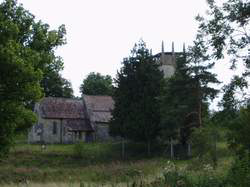Nevertheless the Ministry of Transport agreed that a public inquiry should be held before any decision to close Imber for good. It took place on 3 and 4 October in the council chamber in Trowbridge. An account of the proceedings can be read in Chapter 8 of Little Imber on the Down. Speakers on behalf of the army and the Ministry of Defence described the variety of training procedures used on the Imber Ranges, and affirmed that if it became impossible to continue to use the whole area and the village itself then large tracts of land would have to be acquired somewhere else.
The Ministry of Transport published its decision early in January 1962. The closure of rights of way on the Imber Ranges would be made permanent. It did, however, endorse concessions made by the Ministry of Defence whereby they promised to develop a path around the perimeter of the area and to allow the roads to be used for a maximum of 50 days per year.
Although the possibility that residents might return to Imber faded long ago public awareness of Imber and its fate has continued at a high level. Someone who has done much to keep alive its memory is Ruth Underwood. Ruth Underwood, daughter of Austin Underwood, has adopted the slogan Forever Imber. She organises religious and musical events at Imber which as well as maintaining the memory of the village have the aim of promoting peaceful solutions to the problems of the world.
The local press, and sometimes the national press, often report on commemorative events at Imber. Over the last few years these have included:
· In August 2003 a concert of music by the composer Giya Kancheli. The concert was organised by Artangel, who produced a film for the BBC about Imber, the composer and his roots in Georgia, rehearsals, and the concert itself. An additional form of entertainment for people coming to the concert was a full size house made out of plastic that could be seen moving slowly down the main street of Imber and disappearing behind a tree.
· On Saturday 3 January 2003 a service in St Giles’ church to mark the sixtieth anniversary of the evacuation of the village. As more than 300 people attended many of them had to remain standing in the aisles.
· On Easter Sunday 2004 a community arts day organised by Ruth Underwood. People of different religious faiths were invited, and one of the aims was to meditate on how to create a culture of peace instead of violence and Imber's potential to play a future part in it.
· Playing a specially recorded sound of bells tolling during the period in the summer of 2004 when the village was open to the public.
· A “Peace is Possible” festival on 27 August 2004. It included a flower festival, an exhibition celebrating the history of Imber, and a variety of workshops.
· On New Year’s Eve at the end of 2005 the fourth annual Interfaith Peace Vigil. On this occasion the vigil was dedicated to Norman Kember, at that time still being held hostage in Iraq, and Gill Hicks, who lost both her legs in the London bombings of 7 July.
